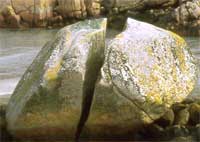Difference Between Erosion and Weathering
 Today’s world is becoming more and more environmentally conscious. Consequently, erosion appears quite often in the nightly news. It is sometimes used interchangeably with weathering. However, the fundamental processes behind erosion and weathering are vastly different.
Today’s world is becoming more and more environmentally conscious. Consequently, erosion appears quite often in the nightly news. It is sometimes used interchangeably with weathering. However, the fundamental processes behind erosion and weathering are vastly different.
The key factor in erosion is movement. Erosion describes the movement of soil and mineral particles that have been loosened from the substrate.
Weathering occurs without movement. Weathering involves breaking down the substrate by chemical or physical means.
Types of Erosion
- Gravity ‘“ loose particles are pulled downhill. This can sometimes have a snowballing effect.
- Ice ‘“ the most common form involves glaciers scraping up loose substrate and pushing it in front of them.
- Water ‘“ particles are loosened and picked up by raindrops or flowing surface water.
- Shoreline ‘“ the sand and rock on the shoreline is pounded by the movement of a river or waves. Particles are loosened and swept away in the water.
- Wind ‘“ loose soil and rocks are picked up by the wind and carried away.
Types of Weathering
Chemical
- Dissolution ‘“ all rainwater is slightly acidic and this acid can start to slowly breakdown solid rock.
- Hydration ‘“ oxygen and hydrogen ions from water molecules attach to rock minerals. The added weight can lead to cracking and breaking.
- Oxidation ‘“ the weakening of minerals such as iron by exposure to oxygen in air and water. Also known as rusting.
- Biological ‘“ acid released by plants such as moss break down rock.
Physical
- Thermal expansion ‘“ when the temperature rises, rocks expand slightly. The reverse is true for falling temperatures. When this occurs quickly, rocks can crack.
- Frost disintegration ‘“ water gets into rock crevices. When the water freezes the pressure can further split the rock.
- Hydraulic action ‘“ incoming waves pressurize the air trapped in rocky crevices. Outgoing waves release this pressure explosively.
Biological ‘“ plant roots and burrowing organisms disturb the substrate and allow other chemical and physical weathering forces easy access.
Weathering and erosion work together to degrade the soil and wear away cliffs and shorelines. Humans contribute to the intensity of weathering and erosion by breaking up and washing away the substrate through harmful farming and construction methods.
Summary:
1.Weathering involves breaking up rocks and soil. Erosion involves moving the broken up particles.
2.Both weathering and erosion are caused by many factors.
3.Weathering and erosion work together to degrade the soil and change our landscape.
- Difference Between Schizophrenia and Psychosis - March 7, 2024
- Difference Between African and Asian Elephants - March 7, 2024
- Difference Between Sunscreen and Sunblock - February 15, 2024
